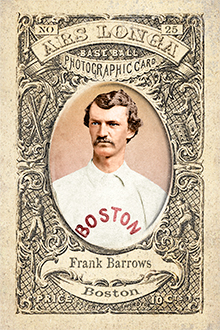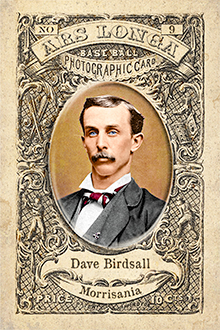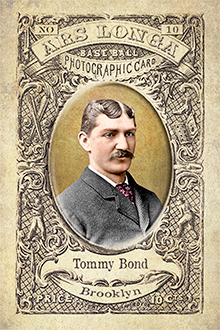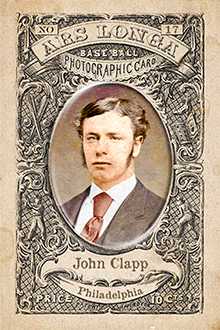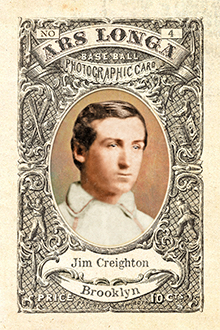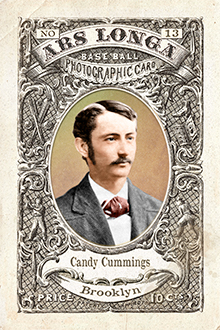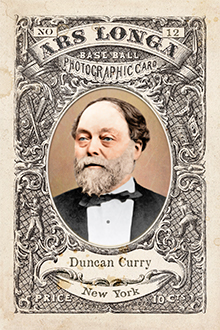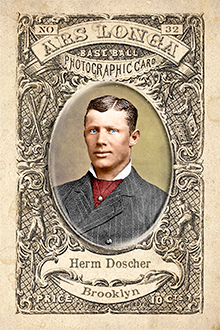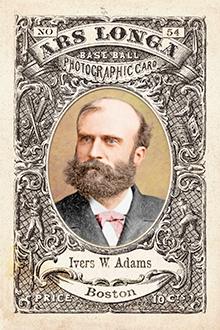
- Series: Pioneer Portraits I: 1850-1874
- City: Boston
- Team: Red Stockings (NAPBBP)
- League: National Association (NABBP)
Ivers Whitney Adams (1838-1914) was a young and ambitious visionary when he first laid eyes on Harry Wright’s new invention: professional baseball. The Cincinnati Red Stockings came to town to trounce the local Lowell lads in a June exhibition on the Boston Commons June 10, 1869. Adams was intrigued and pursued a notion for transforming Boston into a leading post-war metropolis with baseball as an engine of growth. By January 1871, the plans were laid, the Wright brothers were brought on board and the most enduring franchise in professional sports was established -- then the Boston Baseball Association, now the Atlanta Braves.
Ivers was already well on his way to wealth and fame as a patron of Boston’s industrial and social scene. His love of outdoor sports and camaraderie with his up-and-coming peers fit perfectly with the new game about to sweep America. He procured the incorporation, acquired a playing field, set the ticket prices (at Harry Wright’s urging: double the usual fee), and marketed them through George Wright’s sporting-goods emporium. Thus was baseball born in Beantown.
- Adams had vowed to friends that, if he couldn’t recruit the Wrights, he’d abandon the effort to bring the game to Boston. He only wanted the very best.

- Series: Pioneer Portraits I: 1850-1874
- City: New York
- Team: Knickerbockers
Daniel Lucius Adams (1814-1899) was playing baseball before the game was well organized or codified. He and other young doctors in New York simply found the game a great outdoor exercise. He was part of the New York Base Ball Club by 1840, five years before joining the Knickerbockers, considered by many to be the developers of the game we know today. Whatever he called it, Doc would go on to write the book on the national pastime, literally. Adams was a perennial leader among the founding fathers of the day. He advocated or arbitrated the evolving rules that came to shape the game: nine players, nine innings, ninety feet between the bases (forever to be the gold standard of human perfection). Historian John Thorn has decreed Doc as “first among the Fathers of Baseball.” The list of credentials supporting that title are too numerous to detail here. The origins of the American Game have always been curiously shrouded. The luminaries who invented the game were largely anonymous for decades. Once the Abner Doubleday myth was finally punctured, it has remained for modern historians to fill the gaps and Doc Adams has rightly assumed a prominent place in the pantheon.
- Credited with creating the shortstop position, first as a relay man when the flimsy balls made outfield throws difficult, then as a key spot in the infield defense
- In 2016, Adams' 1857 “Laws of Baseball” brought the phenomenal sum of $3.26 million at auction amid a trove of documents from that era
- Doc Adams was SABR’s Overlooked 19th Century Baseball Legend for 2014
- Doc Adams’ candidacy for election to the National Baseball Hall of Fame was finally put to vote when he appeared on the Pre-Integration Era Committee Ballot for 2016. Needing 12 of the 16 committee members’ votes for election, Doc unfortunately fell two votes short.

- Series: Pioneer Portraits I: 1850-1874
- City: Rockford
- Team: Forest Citys (NABBP)
- League: National Association (NABBP)
Robert Edward Addy (1845-1910) was in mid-career when he played for the Hartford Dark Blues in 1874. Having spent his early amateur and pro years with the Rockford Forest Citys, Bob was just the type of player Hartford treasured: an innovator. The hometown club of Mark Twain, the Dark Blues produced a remarkable string of “firsts” (for good and ill): 1) first team to have a captain; 2) who was also the first Jewish player in the majors—Lip Pike; 3) first to throw the curve—Candy Cummings; 4) first to bunt—Tommy Barlow; sadly, Barlow became the first big leaguer to forfeit his career to drug abuse; 5) first (and only) umpire to be expelled for throwing a game—Richard Higham, retired player. To this list was added Addy, the first to slide, a feat he piloted long before his season in CT. Not content with one “first” Bob sought years later to add “inventor of baseball on ice” to his resume, but for some reason, the idea never caught on. Ars Longa is indebted to historian David Arcidiacono for the above tidbits about Hartford's ball club. Addy was nicknamed “The Magnet” for his skill afield that helped the Boston Red Stockings to a pennant in '73. In fact, Addy was paid a superb tribute by no less than Cap Anson who, in a turn of the century book said: “Bob Addy, who was one of the best of the lot, was a good, hard hustling player, a good base runner and a hard hitter. He was as honest as the day is long . . . He was an odd sort of a genius and quit the game because he thought he could do better at something else.” Something involving bats and rinks apparently.
- Addy batted .277 for his pro career with a sole home run
- He managed parts of two seasons with the Philadelphia White Stockings and Cincinnati Reds
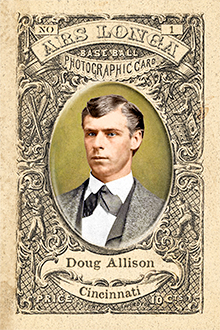
- Series: Pioneer Portraits I: 1850-1874
- City: Cincinnati
- Team: Red Stockings (NABBP)
- League: National Association (NABBP)
Douglas L. Allison (1846-1916) helped create the “Dead Ball Era” by cannily moving his catcher position closer to the plate, thus drastically reducing steals. Run production plummeted from 50-60 per game thanks in part to this savvy early player. Doug was present at the creation of professional baseball: an original Cincinnati Red Stocking in the NABBP.
- Later, Doug starred for the Washington Olympics, inaugurating the National Association (NAPBBP) in 1871
- He is credited as the 1st professional player to use a glove when he donned buckskin mittens to catch a game for the Cincinnati Red Stockings against the Washington Nationals, 6.28.1870
- Purportedly made pitchers chase down their own wild pitches
- Allison was hearing impaired. The Boston Globe reported that Allison suffered his hearing loss during his service with the Union Army during the Civil War.
- Brother Art Allison was an MLB outfielder over five seasons, 1871-1876
- Occasionally umpired games from 1872-1875
- Managed the 1873 Elizabeth Resolutes of the NA to a 2-21 record.
- Because he played in the second game in MLB history (5.5.1871), he is credited with the 17 other players that day as the 27th player to debut in MLB. (The 18 players in game #1 are all credited as the 9th player to debut in MLB).
- Died at age 70 en route to his job at the Post Office
These are reportedly Allison's hands after years of catching barehanded:

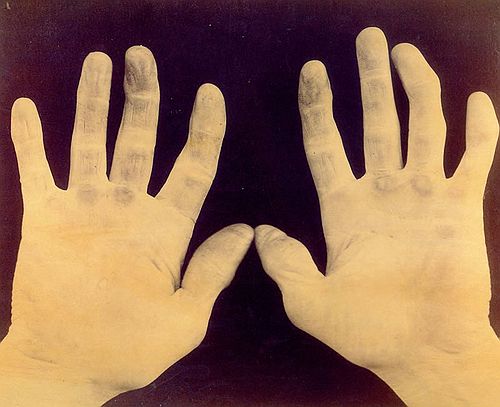
- Series: Pioneer Portraits I: 1850-1874
- City: Marshalltown
- Team: Stars (Amateur)
- League: Independent
- Hall: National Baseball Hall of Fame
Adrian Constantine Anson (1852-1922) was Mr. Longevity, a big, brawling cyclone of controversy & batsmanship unrivaled in the early days of pro ball. He set hitting standards that only the greatest future players would approach or break. He also, by dint of his ferocious personality, may have been the single greatest force for segregation in baseball until Branch Rickey began to reverse that sad estate.
- Played a record 27 consecutive years in the NL
- First batter to 3000 hits, using his powerful arms to create line drives with a short swing
- Managed the Chicago NL team to five pennants and still holds the Cub franchise records for hits, doubles, runs scored and runs batted in
- Elected to Hall of Fame: 1939
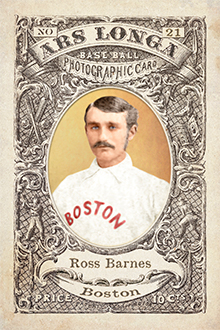
- Series: Pioneer Portraits I: 1850-1874
- City: Boston
- Team: Red Stockings (NAPBBP)
- League: National Association (NAPBBP)
Charles Roscoe Barnes (1850-1915) was the best player in the five year history of the fist professional baseball league, the National Association of Professional Baseball Players (NAPBBP), 1871-1875. Barnes is the all-time NAPBBP leader in runs, hits, doubles, walks, stolen bases, total bases, batting average, OBP and SLG%. He then dominated the National League in its inaugural year, 1876, leading the league hits, runs, average, OBP, SLG%, total bases, doubles, triples and walks. He also hit the 1st HR in National League history, for the Chicago White Stockings, 5.2.1876. Over the first six years of his major league career, Barnes' batting average was .397. An unidentified illness limited Barnes to just 22 games in 1877, and he was never the same player again, retiring shortly thereafter at the age of 31.
“Roscoe C. Barnes…was the greatest second baseman the game ever had…” - A History of the Boston Baseball Club, 1897.
"No matter how great you were once upon a time — the years go by, and men forget. Ross Barnes, forty years ago, was as great as Cobb or Wagner ever dared to be. Had scores been kept then as now, he would have seemed incomparably marvelous.” - W.A. Phelan, Baseball Magazine, 1915
- Because he played in the second game in MLB history, is credited with the 17 other players that day as the 27th player to debut in MLB
- 1st hitter to win batting titles in 2 leagues: NA in ’72-73 and NL in ‘76
- In 1918, made Cap Anson’s all-time team as the shortstop
- Barnes was selected as SABR’s ”Overlooked 19th Century Baseball Legend “ for 2013
- Series: Pioneer Portraits I: 1850-1874
- City: Boston
- Team: Red Stockings (NAPBBP)
- League: National Association (NAPBBP)
Franklin Lee Barrows (1844-1922) played just one season for the Boston Red Stockings of the National Association of Professional Base Ball Players, in the outfield for 18 games in 1871. Despite batting .151, Barrows knocked in 11 and scored 13 in 18 games, which appears productive – but league average for runs per game was 10.5 in 1871, with some scores running into the 30s.
- Debuted with the Boston Tri-Mountains of the NABBP from 1867-70
- Boston played only 40 games in 1871
- Al Spalding started 31 of the team’s games with manager Harry Wright starting nine
- Three teammates: George Wright, Cal McVey and Ross Barnes hit over .400 that year
- Series: Pioneer Portraits I: 1850-1874
- City: Philadelphia
- Team: Whites (NAPBBP)
- League: National Association (NAPBBP)
George A. Bechtel (1848-1921) led a life and career that mirrored the best and worst of baseball’s earliest days. He was a stand-out pitcher, fielder and hitter for amateur teams in the 1860s, a leader for four Philly teams in the NABBP 1867-70, and joined the Athletics when pro ball was born in ’71. He played in all five seasons of that foundational pro league before ending his tenure with the Louisville Grays in the NL’s inaugural season. Famed Henry Chadwick noticed anomalies in Bechtel’s game, untimely “errors” that cast suspicion on George’s integrity. Finally, an incriminating telegram offering to throw a game led to a lifetime ban.
- Pitched every one of the Centennials’ 14-game season in ’75. Along with Bill Craver, became the first players sold to a rival team, returning him briefly to the Athletics
- Series: Pioneer Portraits I: 1850-1874
- City: Troy
- Team: Haymakers
- League: National Association (NAPBBP)
- Hall: Cuban Baseball Hall of Fame
Esteban Enrique "Steve" Bellán (1849-1932) was one of the first Latin players in American pro baseball. Born in Cuba and educated in NY during the Civil War, Bellán played for the Unions of Morrisania and Troy Haymakers of the NABBP and the NAPBBP at the dawn of pro sports franchises. A stylish infielder, Steve was nicknamed the “Cuban Sylph.” Bellán attended Fordham University, the innovator of nine-man college baseball with a game against St. Francis Xavier College on Nov 3, 1859.
- Upon gaining US citizenship, Esteban returned to Havana and helped found Cuban baseball in 1874
- Piloted Club Habana to 3 titles from 1878-83
- Oftentimes cited as the "Father of Cuban Baseball"
- Elected to Cuban Baseball Hall of Fame: 1961
- Series: Pioneer Portraits I: 1850-1874
- City: South Bronx
- Team: Union of Morrisania
- League: National Association (NABBP)
David Solomon Birdsall (1838-1896) was an outfielder with the Boston Red Stockings of the National Association of Professional Base Ball Players over 3 seasons: 1871-73. Previously, he had played for 4 teams in the National Association of Base Ball Players in the amateur era, beginning with the Metropolitans of NY club in 1858.
- Part of the 1872 championship team with Al Spalding under player-mgr Harry Wright
- Per Sporting Life, August 22, 1891: Birdsall “engaged in laying the foundation of Boston’s greatness as a base ball centre.”
- Birdsall's image appears on what may be the 1st true baseball card, “The Old Man” per REA research
- Series: Pioneer Portraits I: 1850-1874
- City: Brooklyn
- Team: Atlantics
- League: National Association (NAPBBP)
Thomas Henry Bond (1856-1941) entered pro ball as the 1st Irishman to do so, and survived to become the last living member of the NL’s first season. In between, he was a force of nature on the mound, leading the NL in wins twice, winning 40+ from 1877-1879 for the Boston Red Caps.
- Hurled 386 complete games in 406 starts with 42 shutouts and ERA of 2.31
- In 1877 won the “triple crown” with 40 wins, 2.11 ERA and 280 SOs
- Compiled a career 234-169 record with a 2.14 ERA, 10th in MLB history
- Bond appeared only once on the Hall of Fame ballot, in 1936, and received only 1% of the votes by the Veteran’s Committee
- Series: Pioneer Portraits I: 1850-1874
- City: New York
- Team: Knickerbockers
- Hall: National Baseball Hall of Fame
Alexander Joy Cartwright (1820-1892) was declared the inventor of baseball by an act of Congress in 1953. A founding member of the Knickerbocker Base Ball Club in 1842, Cartwright is oftentimes falsely credited with establishing the 9 player “diamond” format in 1845. Modern researchers have largely debunked the historical import of Cartwright’s influence upon the game, its rules and development during those early formative stages, citing a propagandizing campaign by Cartwright’s son as a primary source of myth-making.
- The Knickerbocker rules form the foundation of the modern game
- Thanks to such rules, runners are no longer “tagged out” via thrown balls
- The diamond’s dimensions were termed by Red Smith “the closest man has ever come to perfection.”
- Elected to Hall of Fame: 1938

- Series: Pioneer Portraits I: 1850-1874
- City: Philadelphia
- Team: Pythian B.B.C.
- League: National Colored Baseball League
Octavius Valentine Catto (1839-1871) died a martyr for civil rights in Philadelphia amid violent Reconstruction Era political strife when he was shot three times and killed while on his way to vote. Only a few years before, he had been a pioneer in the early days of baseball as founder of the Pythian Base Ball Club in 1867. The emerging national game was shedding its elitist roots of pre-Civil War days and Catto was trying to make it a truly all-American sport. He sought membership for his club in the National Association and, in 1869, organized the first inter-racial match in Philadelphia versus the Olympic Ball Club. Catto had dedicated his life to the pursuit of freedom. He was an educator and mentor of black men, a military leader during the war, and ended his life in the forefront of the political struggle, including the integration of Philadelphia’s transit system. He brought to baseball the same passionate devotion that characterized his all-too-short life.
- The “gentlemen’s agreement” adopted by white baseball executives in response to Catto’s bid held sway – with very few exceptions – until 1947 when another talented infielder finally broke the color barrier
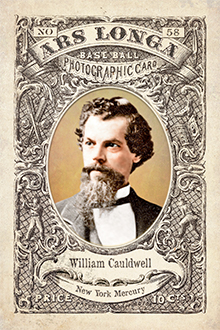
- Series: Pioneer Portraits I: 1850-1874
- City: New York
William Pierce Cauldwell (1824-1907) was, per the New York Tribune’s obituary, “the father of Sunday journalism.” More significantly for baseball, Cauldwell was the first publisher to dedicate regular space and ink to the game of baseball as news (starting in 1853), while also serving as mentor to the “Father of Baseball,” Henry Chadwick, whom he hired in 1858 to report on the new “national pastime” - a phrase Cauldwell’s Sunday Mercury newspaper coined on December 5, 1856.
Cauldwell had begun as a typesetter in 1841 before becoming publisher of the Sunday Mercury in NYC. In 1853 he began covering the games between the Knickerbockers and Gothams, introducing a wide audience to this phenomenon of outdoor athletics. He charted its course, reporting on the exponential growth of clubs all over the country. In his summary of the game in 1860, Cauldwell’s column no longer was long enough to list all the teams. He noted that California had seen its first game played on Feb 22 of that year.
- Cauldwell was active in politics, serving in the NY Senate and State Assembly as well as being a Supervisor of The Bronx before its annexation into NY City
- Series: Pioneer Portraits I: 1850-1874
- City: New York
- Hall: National Baseball Hall of Fame
Henry Chadwick (1824-1908) is widely considered the “Father of Baseball” due to his profound influence on early public awareness of the game and upon its foundational rules. A journalist from Brooklyn, Chadwick was present at the creation as he saw the new game developing in the 1860s and began what would become sports reporting today.
- Literally wrote the book on baseball: Beadle’s Dime Base Ball Player in 1860
- Edited Spalding’s Official Base Ball Guide for decades
- Saw to it we don’t have tie games or one-bounce outfield put-outs today
- Elected to Hall of Fame: 1938
- Series: Pioneer Portraits I: 1850-1874
- City: Philadelphia
- Team: Athletics (NABBP)
- League: National Association (NAPBBP)
John Edgar Clapp (1851-1904) played for 8 teams and managed 6 over a 12 year span, beginning in the National Association with the Middletown Mansfields in 1872 and ending with the NY Gothams in ’83. Primarily a catcher, Clapp had a career BA of .283. With a lifetime 2,523 ABs, he struck out only 51 times.
- Was the first player-manager in major league history (1872)
- Jay Jaffe's JAWS system ranks John as the 88th best catcher in MLB history, just after Bubbles Hargrave and before Ed McFarland
- Earned the nickname “Honest John” after reporting a bookie’s attempted bribe to local police
- The 1881 bribe, in current dollars, amounted to @$119,000
- Fittingly, this Honest John entered police work after retirement from the game and died on the job in his hometown of Ithaca, NY
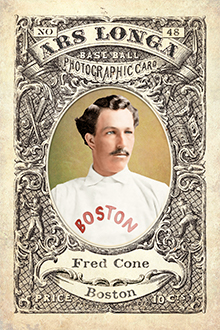
- Series: Pioneer Portraits I: 1850-1874
- City: Boston
- Team: Red Stockings (NAPBBP)
- League: National Association (NAPBBP)
Joseph Frederick Cone (1848-1909) played professionally for the Boston Red Stockings of the old National Association in 1871 and, at age 30, one season with the minor-league New Bedford/New Haven/Hartford club in the International Association. The Bostons were among the elite of their day with George and Harry Wright, and a young Al Spalding on the mound. In his latter stint, Fred played with many who would go on to major-league careers of note. Among them: Billy Barnie, Roger Connor, Jim Mutrie, and Harry Stovey. Such was the opportunity that lay before young ballplayers of that era. The game was rapidly establishing itself in the nation’s consciousness. History was being made and traditions were being formed.
- Cone batted .260 in his major-league campaign. In between his time in Boston and Connecticut, Fred was an umpire for two seasons: 1875 in the NA and 1877 in the NL
- Played amateur ball for the Rockford Forest Citys in 1868-69 before following teammates Spalding and Ross Barnes to Boston
- Rockford may have been the first to pay players, at least for their “practice” time
- Series: Pioneer Portraits I: 1850-1874
- City: Brooklyn
- Team: Excelsiors
- League: National Association (NABBP)
James Creighton, Jr. (1841-1862) was a star pitcher for the Excelsior of Brooklyn from 1860-62. Widely regarded as the game’s 1st superstar and, perhaps, its 1st martyr. His unique pitching motion propelled him to fame, but his death from a ruptured hernia caused while hitting a home run gave this young man a place in the Pantheon of early greats.
- John Thorn, official historian of MLB, has called Creighton the “most important player not inducted into the Hall of Fame”
- Threw baseball’s 1st shutout: 11.8.1860
- In 1866 baseball made a small contribution to national reconciliation as the Washington Nationals came to Brooklyn for a match. Both clubs retired to the Creighton monument where, per the NY Times, “a silent tear was dropped to [his] memory…”
- Series: Pioneer Portraits I: 1850-1874
- City: Brooklyn
- Team: Star of Brooklyn
- League: National Association (NABBP)
- Hall: National Baseball Hall of Fame
William Arthur Cummings (1848-1924) has a plaque in Cooperstown today, not because of his won-lost record or ERA – both of which were excellent; but primarily because he is credited with inventing the curveball, and was able to throw it effectively under the combat conditions of early baseball. A star for the Brooklyn clubs in the old NABBP in the 1860s, Cummings continued to be effective in the pro era until 1877.
- Cummings got the idea for the curve from a day at the beach chucking clam shells
- Once catcher Nat Hicks moved close behind the batter, the curve became a viable pitch
- Elected to Hall of Fame: 1939
- Series: Pioneer Portraits I: 1850-1874
- City: New York
- Team: Knickerbockers
Duncan Curry (1812-1894) is one of a group of illustrious founders of the Grand Old Game. Several have been put forward as the true “Father of Baseball” and Curry’s claim is as sturdy as any. A founder of the Knickerbocker Club (a requisite for paternity), Curry was an integral part of the beginnings of the game, including participation in the “first” game: in Hoboken NJ June 19, 1846.
- The NJ interlopers destroyed the Knickerbockers in that game 23-1
- Curry blamed the loss on overconfidence and an opposing pitcher with blinding speed
- In 1856 Curry’s preferred seven-inning format lost out to Louis Wadsworth’s nine, signaling the transition of the game’s growth out of the hands of the founding Knickerbockers
- Series: Pioneer Portraits I: 1850-1874
- City: Brooklyn
- Team: Atlantics
- League: National Association (NABBP)
John Henry “Herm” Doscher, Sr. (1852-1934) was a no-nonsense player from 1872-82 and then umpired for three full seasons. He was not above using force to control unruly players. Herm was embroiled in a dispute with management over a contract that led to his temporary ouster from baseball before being exonerated in court and reinstated. He once recalled his days officiating games: “I’ve got to play ring master, school teacher, poppa, momma, and doctor in every game.”
- Doscher’s son Jack became the first second-generation major leaguer in 1903
- As a scout, Herm was credited with discovering Wee Willie Keeler
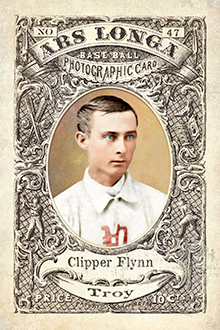
- Series: Pioneer Portraits I: 1850-1874
- City: Troy
- Team: Haymakers
- League: National Association (NAPBBP)
William Flynn (1849-1881) was one of the remarkable group of early baseball players to come out of Lansingburg (Troy) NY. This small town had an out-sized impact on the game as amateur ball was being born on a national scale right after the Civil War. Flynn was a first-baseman for the Troy Haymakers from 1867-69 before joining teammates in Chicago with the White Stockings in 1870, all with the National Association of Base Ball Players. He became part of the first openly professional sports league when the Haymakers helped form the NAPBBP in 1871. The following season, Flynn moved south for a brief stint with the D.C. Olympics but the club disbanded after a mere nine games in ‘72. The slightly-built Flynn hit .338 in ‘71, ranking with the leaders on the team. He managed only a .225 average in his final tour with the Washingtons. The 1880 census-taker found “Clipper” home in Lansingburg with his wife and four kids where he worked in a brush factory.
- Flynn and his Troy mates did deprive Harry Wright’s all-pro Cincinnati Red Stockings of one more win in their undefeated 1869 season. The teams were deadlocked at 17-17 when the visiting New Yorkers left the field in the sixth inning
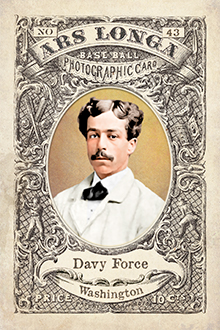
- Series: Pioneer Portraits I: 1850-1874
- City: Washington, D.C.
- Team: Olympics
- League: National Association (NABBP)
David W. Force (1849-1918) played shortstop for Nicholas Young’s Olympic Club in D.C., one of the founding-dozen teams in the new Nat’l Assoc of pro ball. Davy spent a long career moving among the prominent clubs of the first two decades of the national game. In the mid-70s he was regarded as second only to George Wright at his position and was vied for by his Chicago club and the Athletics. The “Force Case” became a cause of action in the formation of the National League in ‘76 as Bill Hulbert was energized to bring order from chaos (though he still lost Davy.) “Wee Davy” was a powerhouse at 5’4” with terrific range and would later be known as a “miniature Hans Wagner.” On Christmas Eve 1896 a murder occurred in San Francisco and the tabloids had a field day mis-identifying poor Davy as the killer. His old mentor Young rescued him from scandal by vouching for the ex-player.
- Force hit .418 in ‘72 and .365 in ‘73 for the Canaries and .249 over his 15 years
- Series: Pioneer Portraits I: 1850-1874
- City: South Bronx
- Team: Union of Morrisania
- League: National Association (NABBP)
John Goldie (c1836-1871) played 1st base for the NY Mutuals beginning in 1862 and later for the Union Club of Morrisania (the Bronx.) He suffered from TB most of his adult life and blamed his work as type-setter. He credited his outdoor play for prolonging his life.
- With Goldie at 1st, Morrisania beat the Atlantics 14-13 for the 1867 NABBP title
- The Union’s star had four hits in a titanic struggle with the Cincinnati Red Stockings who won13-12 on Sep 4, 1869 as the new professionals began to supplant their amateur forebears
- Goldie succumbed to tuberculosis at age 35 in NYC
- Series: Pioneer Portraits I: 1850-1874
- City: Cincinnati
- Team: Red Stockings (NABBP)
- League: National Association (NABBP)
Charles Harvey Gould (1847-1917) played for the 1st professional team, the Cincinnati Red Stockings, who reigned supreme for 2 yrs, winning 84 straight games and barnstorming the country from 1869-1870. Disbanded in ’71, Gould followed Harry Wright to Boston where he inaugurated baseball there and won its 1st title in 1872.
- His fielding prowess earned him the nickname “the bushel-basket”
- Ironically, Gould’s errant throw to 2nd ended his Red Stockings’ duel with the Brooklyn Atlantics, and with it the longest winning streak in baseball history on June 14, 1870
- Was Cincinnati Reds’ first manager: 1876








